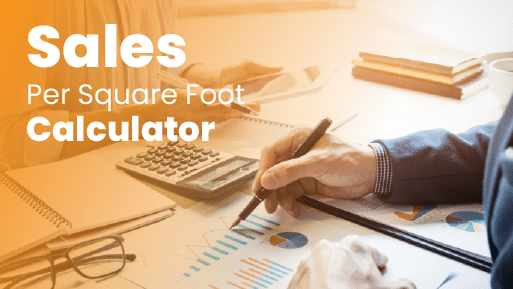How to Calculate Sales Per Square Foot?
To calculate sales per square foot, divide the total sales revenue by the total selling square footage.
The formula is:
Sales Per Square Foot = Total Sales / Total Square Feet
Step-by-Step:
- Determine Total Sales
Use gross sales revenue over a specific period (e.g., monthly, quarterly, annually).
Example: $500,000 annual sales - Measure Total Selling Space
Measure in square feet only the area used to sell products (excluding storage, offices, etc.).
Example: 2,000 square feet - Apply the Formula
Divide total sales by total selling space.
Example: $500,000 ÷ 2,000 = $250 per square foot
Why Sales Per Square Foot Matters?
Sales Per Square Foot (SPSF) is more than just a number. It’s a lens into how efficiently your retail space is performing.
Whether you operate a boutique, a national chain, or a pop-up store, knowing your SPSF helps you make smarter decisions, fix inefficiencies, and make the most of your (often quite expensive!) retail space.
Here’s why it’s so crucial:
1. Optimize Store Layout and Merchandising
A high SPSF often signals that your layout and product placement drive strong revenue per area. If certain areas of your store are underperforming, you can reallocate space to better-performing products or categories.
Understanding your inventory turnover ratio and using an inventory turnover ratio calculator can help in evaluating your best and worst selling product. SPSF helps identify what’s working and what’s wasting valuable floor space.
2. Make Informed Leasing Decisions
Rent is often calculated based on square footage, so understanding how much revenue you generate per square foot helps determine if a location is worth the cost. It also provides leverage in lease negotiations and site selection for expansion.
3. Benchmark Performance Across Locations
If you manage multiple stores or franchises, SPSF gives you a consistent metric to compare performance, regardless of store size. A small store with a high SPSF might outperform a larger one with more sales but lower efficiency.
4. Attract Investors and Stakeholders
Investors look for strong unit economics, and SPSF is a reliable KPI that indicates operational efficiency. It helps demonstrate profitability potential, especially for brick-and-mortar retail in an increasingly digital marketplace.
Who Should Use The Sales Per Square Foot Calculator?
The Sales Per Square Foot Calculator is a practical tool for anyone looking to evaluate retail performance and optimize their space.
Here’s a breakdown of who can benefit most:
1. Retail Store Owners & Managers
Whether you run a small boutique or a multi-location franchise, knowing your sales per square foot helps identify which locations are thriving and which may need layout adjustments or promotional support. Watch the testimonial video below to hear Kristen, a liquor store owner, talk about the features of KORONA POS, including Sales Per Square Foot (SPSF).
2. Real Estate Analysts & Brokers
Commercial real estate professionals use SPSF to assess the revenue potential of retail spaces. It helps determine appropriate rent pricing, attract the right tenants, and justify lease recommendations with hard data.
3. Franchise Operators
Franchisees and franchisors alike can use this metric to monitor consistency across locations and enforce brand-wide performance standards. It’s a powerful benchmarking tool that ensures space is being utilized efficiently.
4. eCommerce Brands with Physical Touchpoints
Online-first brands expanding into brick-and-mortar (via pop-ups or showrooms) can use SPSF to evaluate the success of physical retail experiments. The data informs whether to scale, adjust, or pivot location strategies.
5. Retail Consultants & Business Coaches
Professionals advising retail clients can use this calculator to support their assessments, back up recommendations with quantitative insights, and track progress over time.
6. Investors & Lenders
Those financing or investing in retail operations look at SPSF to gauge operational efficiency and revenue density. A higher number often indicates a more viable and profitable venture.
Common Mistakes to Avoid When Using a Sales Per Square Foot Calculator
Calculating sales per square foot (SPSF) seems straightforward, but minor oversights can lead to misleading results that skew business decisions. Here are the key pitfalls to watch out for when using an SPSF calculator and tips to stay on track.
1. Using Inaccurate or Incomplete Data
One of the most frequent errors is inputting incorrect or incomplete data into the SPSF calculator, which can drastically distort your results.
Businesses may pull sales figures from inconsistent periods (e.g., mixing monthly and annual data) or miscalculate the square footage by including non-selling areas like storage rooms, offices, or restrooms.
Ensure you use total sales revenue from a consistent period (e.g., monthly, quarterly, or annual). Cross-check with POS reports or accounting software.
Discover Advanced Analytics and Custom Reports
Speak with a product specialist and learn how KORONA POS can work for your business.
2. Ignoring Industry or Location Context
SPSF is only meaningful when compared to relevant benchmarks, and failing to account for context can lead to misinterpretation.
Businesses may assume their SPSF is “good” or “bad” without comparing it to industry averages, competitor performance, or location-specific factors like foot traffic or demographics.
Look up SPSF averages for your sector (e.g., grocery stores ~$500/sq ft, apparel ~$300-$400/sq ft, per retail industry reports). Sources like trade associations or market research firms can provide these figures.
3. Over-Relying on SPSF as the Sole Metric
A high SPSF doesn’t always mean profitability. Combine SPSF with metrics like gross margin, foot traffic, conversion rates, average inventory, or average transaction value to get a fuller picture of performance.
Consider customer experience, brand positioning, or product mix, which SPSF doesn’t capture but can influence long-term success.
4. Failing to Account for Seasonal or Temporary Factors
SPSF can fluctuate due to seasonal trends or one-time events, and ignoring these can skew your analysis.
Calculate SPSF over a full year or compare the same periods (e.g., Q1 2024 vs. Q1 2025) to account for seasonality. Exclude one-time events (e.g., a clearance sale) or note their impact when interpreting results.
5. Misinterpreting Square Footage Adjustments
Some businesses incorrectly adjust their square footage calculations. Retailers might include or exclude areas (e.g., fitting rooms, display areas) inconsistently across calculations or fail to account for shared spaces in multi-tenant properties.
Decide whether to include ancillary spaces and apply the same standard consistently. Note which areas are included in your square footage to ensure repeatability.
Where to Find a Sales Per Square Foot Calculator
There are several ways to access or create an SPSF calculator, from free online tools to custom solutions built into existing software. Below, we explore the best places to find an SPSF calculator, how to use them, and how to create your own.
1. Online SPSF Calculators
Many websites and business platforms offer free or subscription-based SPSF calculators that are user-friendly and require minimal setup. These tools are ideal for small business owners or managers who need quick insights without complex software.
2. Point of Sale and Retail Management Software
Many modern POS systems and retail management platforms include SPSF calculators or the ability to generate SPSF reports as part of their analytics suites. These are particularly useful for businesses already using such systems for daily operations.
KORONA POS provides detailed retail analytics, often including space efficiency metrics like a sales per square foot calculator for multi-location retailers.
Speak with a product specialist and learn how KORONA POS can power your business.
3. Creating Your SPSF Calculator with Spreadsheets
Building a custom SPSF calculator using spreadsheet software like Microsoft Excel or Google Sheets is a cost-effective and flexible option for businesses that prefer a tailored solution or don’t have access to advanced POS systems.
Getting an Accurate Sales Per Square Foot Calculator With KORONA POS
KORONA POS combines ease of use, scalability, and industry-specific features to deliver the most accurate SPSF calculations.
Its cloud-based platform, real-time analytics, and customizable reports help retailers to monitor and improve SPSF effortlessly.
Positive user reviews highlight its intuitive interface, exceptional customer support, and ability to scale with growing businesses.
Businesses can start with a free trial to explore these features without commitment, ensuring it’s the right fit for their needs.
Schedule a free demo with one of our product specialists today to see how KORONA POS can transform your operations. No credit card required. Click below to book your demo now.












